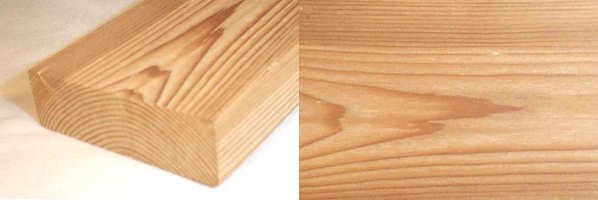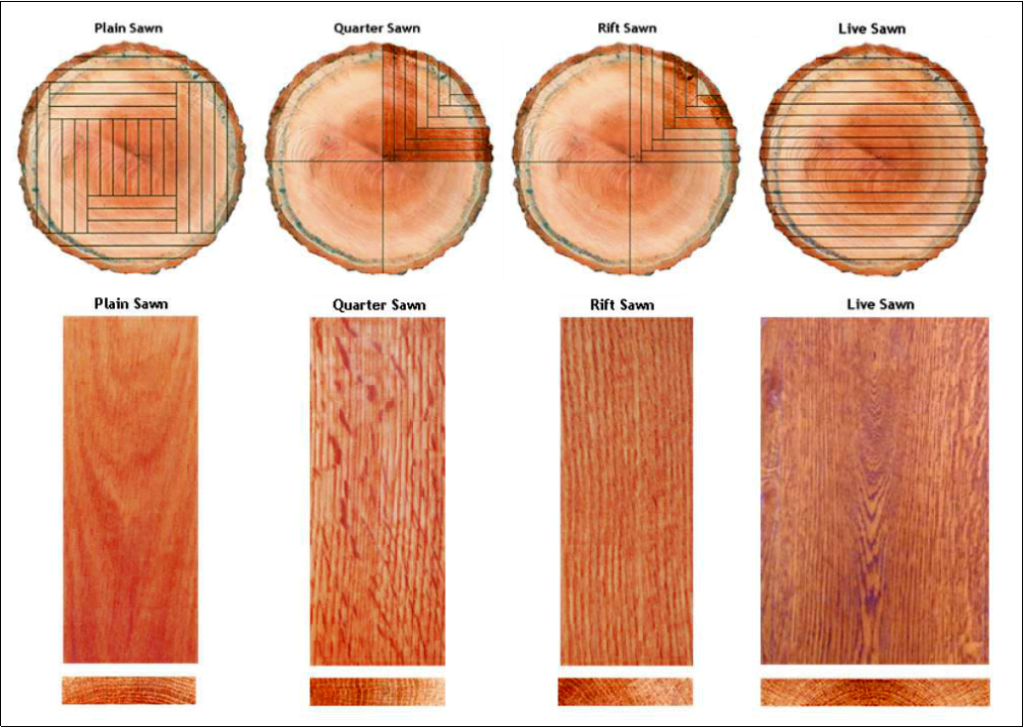When lumber is cut from logs, it is typically cut in one of three ways: quarter sawn, rift sawn or plain sawn. Each type of lumber is dependent on how the log is oriented and cut at the sawmill. The result is a particular orientation of the growth rings on the end grain of the board and is what defines the type of lumber. The type of cut also determines the figure in a piece of wood and the wood’s mechanical properties.
Sound too confusing? This graphic will help…

PLAIN SAWN / FLAT SAWN
Most common, least expensive
Plain sawn, also commonly called flat sawn, is the most common lumber you will find. This is the most inexpensive way to manufacture logs into lumber. Plain sawn lumber is the most common type of cut. The annular rings are generally 30 degrees or less to the face of the board; this is often referred to as tangential grain. The resulting wood displays a cathedral pattern on the face of the board.
Plain sawn advantages
Although not as efficient as live sawn, plain saw milling is still material efficient and has beautiful grain patterns..

QUARTER SAWN
More expensive than plain sawn material
Quarter sawn wood has an amazing straight grain pattern that lends itself to design. Quarter sawn lumber is defined as wood where the annular growth rings intersect the face of the board at a 60 to 90 degree angle. When cutting this lumber at the sawmill, each log is sawed at a radial angle into four quarters, hence the name. Dramatic flecking is also present in red oak and white oak.
Quarter sawn advantages
Quarter sawn wood has an amazing straight grain pattern that lends itself to design. Often used for cabinetry, flooring, high-end custom crafts and furniture, it is the traditional wood used in making mission style furniture. Other wood species that are sought after in quarter sawn are walnut, maple and cherry.
In addition to the desirable grain pattern this type of wood is some of the most dimensionally stable, making it ideal to work with. Quarter sawn lumber exhibits almost no twisting, warping and cupping. It is more resistant to moisture penetration and less prone to surface checking and raised grain.
More dimensionally stable and beautiful to look at? “Is there a downside to it?,” you ask. Well, yes. Because the manufacturing process results in a lower yield and is more labor intensive to produce quarter sawn lumber, the cost is higher. There is also a more limited supply because a smaller number of sawmills produce it.

RIFT SAWN
Most expensive, least common
Rift sawn wood can be manufactured either as a compliment to quarter sawn lumber or logs can be cut specifically as rift sawn. In rift sawn lumber the annual rings are typically between 30-60 degrees, with 45 degrees being optimum. Manufactured by milling perpendicular to the log’s growth rings producing a linear grain pattern with no flecking. This method produces the most waste, increasing the cost of this lumber. Rift sawn lumber is very dimensionally stable and has a unique linear appearance.
Rift sawn lumber is typically narrow with a very straight grain pattern on the face of the board. Rift sawn lumber is usually used with oak to avoid the flecks that are common in the species. The annular rings or a rift sawn board are about 30-60 degrees to the face of the board, but 45 degrees is the most optimum. Similar to quarter sawn lumber, rift sawn lumber is also referred to as radial grain. The most stable boards, and also the most wasteful to produce, are rift sawn planks. Each of these boards is cut radially perpendicular to the growth rings of the tree. There are large triangles of waste left from between each board. As a result, rift sawn lumber is costly to produce and therefore, the most expensive type of planks available from a log.
Rift sawn advantages
Produces the strongest possible boards with the most consistent visual look of long and straight grain patterns. Generally the choice of cut for fine furniture makers looking for consistent patterns throughout their design.

LIVE SAWN MILLING
Most efficient, blended mix of all cuts
Live sawn milling is the most efficient way to cut a log into flooring planks and it is a newer milling method than the others. Each plank is cut straight off of the log in one direction without changing the orientation of the log. This method produces boards with a full range of angles of the log’s rings, also known as the log’s “grain”. The names of these angles can get pretty technical, but we will spare you the details – the angles range from 0 to 90 degrees or so. Live sawn planks include a full range of the log’s characteristics, from the sought-after heartwood where the ring patterns are tightest to the sapwood.
Live sawn advantages
An efficient material with beautiful mixtures of all milling methods included.
